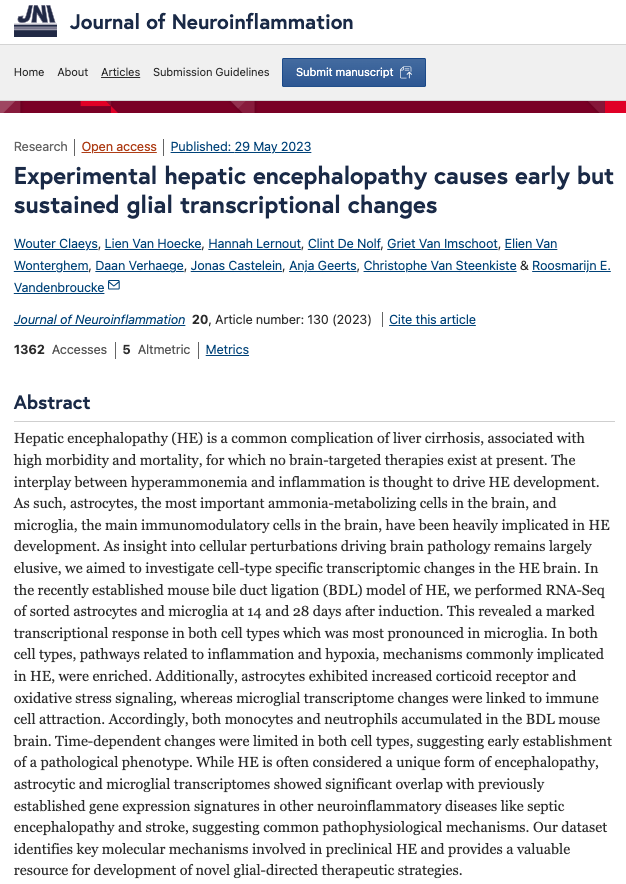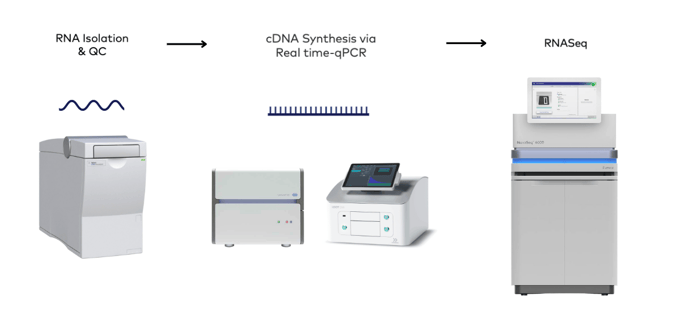Hepatic encephalopathy (HE) is a common complication of liver cirrhosis that is associated with high morbidity and mortality. There are currently no brain-targeted therapies available for HE. The interplay between hyperammonemia and inflammation is thought to drive HE development. Astrocytes, the most important ammonia-metabolizing cells in the brain, and microglia, the main immunomodulatory cells in the brain, have been heavily implicated in HE development.
Experimental hepatic encephalopathy causes early but sustained glial transcriptional changes, a study by Ph.D. and postdocs at the VIB Center for Inflammation Research in Belgium that was published in Journal of Neuroinflammation (Fig. 1) investigated cell-type specific transcriptomic changes in the HE brain. The researchers used the recently established mouse bile duct ligation (BDL) model of HE and performed RNA-Seq of sorted astrocytes and microglia at 14 and 28 days after induction.

Figure 1. "Experimental hepatic encephalopathy causes early but sustained glial transcriptional changes" in the publication Journal of Neuroinflammation.
The study found that there was a marked transcriptional response in both astrocytes and microglia, with the response being most pronounced in microglia. In both cell types, pathways related to inflammation and hypoxia were enriched. Additionally, astrocytes exhibited increased corticoid receptor and oxidative stress signaling, whereas microglial transcriptome changes were linked to immune cell attraction.
The study also found that there were limited time-dependent changes in both astrocytes and microglia, suggesting that a pathological phenotype is established early in the disease process. While HE is often considered to be a unique form of encephalopathy, the researchers found that astrocytic and microglial transcriptomes showed significant overlap with previously established gene expression signatures in other neuroinflammatory diseases such as septic encephalopathy and stroke. This suggests that there are common pathophysiological mechanisms underlying these diseases.
RNA Isolation and Quality Control
To analyze gene expression, RNA was extracted from sorted cells using the RNeasy ®Plus Micro Kit (QIAGEN). The purity and concentration of the RNA was checked to ensure it was of good quality using RNA 6000 Pico Kit (Agilent) and the Bioanalyzer (Agilent). Next, the RNA was converted into cDNA using the SensiFAST™ cDNA Synthesis Kit (Bioline), so that it can be used for gene expression analysis. Real-time qPCR was performed using the LightCycler 480 system (Roche) and SensiFast SYBR No-Rox (Bioline) to measure the expression levels of specific genes. The researchers used the I.DOT Liquid Handler (DISPENDIX) to dispense all volumes (Fig. 2). The expression levels were normalized to the expression of stable reference genes, which have a constant expression level under different conditions, using the geNorm Housekeeping Gene Selection Software. This helps to ensure that the results are accurate and reliable for RNASeq.

Figure 2. Claeys, W., Van Hoecke, L., Lernout, H. et al. (2023)'s RNA isolation and quality control workflow included the Bioanalyzer 2100 (Agilent), a cDNA conversion step using real-time qPCR via the LightCycler 480 system (Roche) and the I.DOT Liquid Handler (DISPENDIX), and RNASeq using the NovaSeq 6000 (Illumina).
The findings of this study provide valuable insights into the molecular mechanisms involved in HE and could lead to the development of novel glial-directed therapeutic strategies.
Empower Your Research with Liquid Handling Automation
In the ever-evolving world of drug discovery research, precision and efficiency are paramount. That's why we advocate for the integration of the I.DOT, a low-volume non-contact liquid dispenser, into every researcher's arsenal. These innovative tools are not merely replacements for traditional pipettes; they are catalysts for scientific progress.
With their ability to deliver precise volumes of liquids without the risk of contamination, low-volume non-contact dispensers empower researchers to:
- Conduct more accurate and reproducible experiments
- Minimize waste and conserve precious reagents
- Enhance safety by eliminating the risk of hand injuries and exposure to hazardous substances
Embrace the future of scientific research with low-volume non-contact dispensers. Contact us today to learn more about how the I.DOT Non-Contact Dispenser, a game-changing tool, can take your research to new heights.

References
Claeys, W., Van Hoecke, L., Lernout, H. et al. Experimental hepatic encephalopathy causes early but sustained glial transcriptional changes. J Neuroinflammation 20, 130 (2023). https://doi.org/10.1186/s12974-023-02814-w